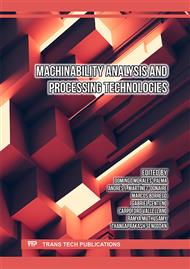p.3
p.13
p.25
p.35
p.45
p.57
p.67
p.77
p.87
Surface Quality Optical Measurement of Part Inclined Planes Manufactured by FDM Technology
Abstract:
Fused Filament Deposition (FDM) additive manufacturing technology allows the generation of three-dimensional parts by overlapping layers of an extruded polymer. The staircase effect caused by overlapping is well known and makes the manufactured parts have poor surface quality. This problem has been focused on by numerous works trying to optimize the surface quality by studying the process technological parameters or part geometry. Also, post-processing techniques have been developed that improve this roughness, but which involve an increase in manufacturing time and cost. In this work, a methodology to measure the roughness based on laser confocal microscopy is proposed. To evaluate the methodology, an experimental study is carried out that relates the surface roughness of parts manufactured with FDM with the building orientation and the layer height. The main objective of this study is to compare two roughness measurement methodologies: a mechanical measurement with a conventional contact roughness meter, and an optical measurement with a confocal microscope. The contact roughness meter provides a direct value of the roughness of the part wall profile, while the confocal microscope provides an image of the three-dimensional surface of the part wall, which must be processed. The data from the confocal microscope are evaluated with the Internet-based software Surface Metrology Algorithm Testing System (SMATS) developed by the National Institute of Standards and Technology (NIST) of the USA. The SMATS will provide an average value of the roughness of the analyzed surface. The test results with both methodologies are very similar, with an average difference of 5%. These results show the influence of the printed plane inclination angle on the roughness, which is higher for low values of the angle. It can also be seen that this influence decreases for low-layer heights.
Info:
Periodical:
Pages:
45-55
Citation:
Online since:
October 2023
Keywords:
Price:
Сopyright:
© 2023 Trans Tech Publications Ltd. All Rights Reserved
Share:
Citation:



